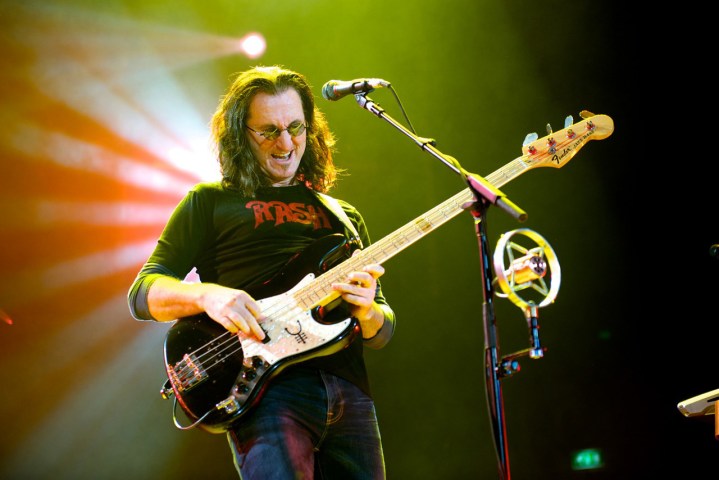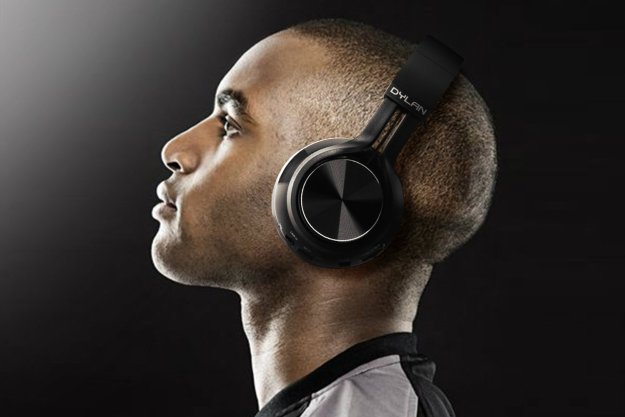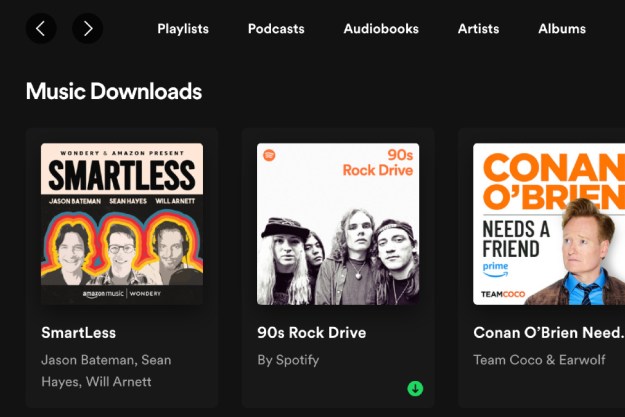
“The secret is, it all comes down to respect.”
It only took five decades, but the band that geeks love and keep closer to their hearts more than any other, Rush, finally made it into the Rock and Roll Hall of Fame in 2013. The band’s three stalwart Canadians — bassist/vocalist Geddy Lee, guitarist Alex Lifeson, and drummer Neil Peart — long ago set the template for virtuosic interplay on both record and onstage. But Lee, the band’s iconic frontman, remains relatively unfazed by the latter-career accolades that just keep on coming.

“It’s really incredibly complimentary to be included in those things, and to be honored in that way is the greatest compliment,” agrees Lee. “It’s not something I walk around thinking about. But I certainly appreciate it, and I’m happy that the work I’ve done in my life has added up to something.”
R40 Live, out today on various formats from Zoe/Rounder, was shot with 14 HD cameras at the Air Canada Centre in the band’s hometown of Toronto this past June, and it fully encapsulates the core values of their triumphant, 35-date 40th anniversary North American tour. R40’s ever-adventurous set list saw Rush literally go backwards in time step by step, from the all-cylinders steampunk roar of Headlong Flight to the philosophical rhythmic drive of Roll the Bones to the relentless mean, mean pride of Tom Sawyer to the ultimate cosmic headbanging of 2112.
Geddy (born Garry Lee Weinrib) and I got on the phone while he was in New York recently to discuss his sonic goals for the tour, his admiration of surround sound, and Rush’s future. This, my friends, is the true spirit of radio.
Digital Trends: What was your sonic plan for a show that essentially moves from the present day all the way back to 41 years in the past?
Geddy Lee: Well, I had this whole concept in my head about devolution. Way back in the summer of 2014, when we were on a break, I got together with Dale Heslip, our art director and film director who’s also very involved in our show designs.
I started talking to him about this devolution concept that might be suitable for an anniversary tour, where you begin with the present day and slowly go back in time in reverse chronological order. And perhaps there was a way we could take the entire show on that journey with us so it’s not just the music that’s winding back in time, but also the visuals. Always from the inception, it had to be a very theatrical show.
He just jumped all over that, and we developed some ideas very quickly. But then I was told the guys were not interested in going out on tour, and that there might not even be a next tour — so it was put up on a shelf, and we went on with life.
Then in November of that year [2014], we had a meeting with the band, and it was decided that the guys were agreeable to doing a short tour, 35 shows. So we dusted that idea off and continued to develop it.
I saw the R40 tour at the Prudential Center in Newark, New Jersey on June 27, and I called it the reverse Pink Floyd/The Wall effect, because we’d see set pieces and big amp stacks constantly being taken away and replaced by different things entirely all throughout the night.
Exactly. All of the amp companies got into the spirit of the concept and were willing to share in what we wanted to accomplish. They were so eager and happy to produce these vintage pieces for us.
I would say it was a remarkable accomplishment. Everybody involved with the show really got it. Whether it was our two amazing carpenters [Cliff Sharpling and John Renner], the guys who were building the props, or the lighting designers — they all got it. It was really a labor of love for them.
You had five decades of material to choose from for the set. Did you have to rearrange certain songs to suit how older material gets played now, to sound more current?
Well, yeah, you try to freshen up something that sounds dated if you can. Some songs are just bass, drums, and guitar, and you just let them rock. Other songs have a little bit more technology involved, so we had to see if there was a way they could be brought into this current era.
We had to see how we could bring vintage songs into the modern era.
We decided to do Jacob’s Ladder [from 1980’s Permanent Waves], which had some keyboard sounds that were dated and really hadn’t withstood the test of time, compared to what we could put together now. My [synthesizer] programmer, Jim Burgess [of Saved by Technology], really worked quite hard on it — and I think he worked even harder, because he liked that song a lot! (both chuckle)
He put together a whole variety of sounds for me to audition, and he really surprised me with all the options, which I think lent to a much more interesting version of it. I think we upped the ante and improved that song.
One of my favorite moments was getting to see Losing It, which was never played live until this tour. In New Jersey, you had Jonathan Dinklage, who was part of the string section during the Clockwork Angels tour, come out to play the electric violin. In Toronto, you brought out your original electric-violin collaborator on the song, Ben Mink. How great was that?
Oh yeah! That was really a great moment. And Johnny did an amazing job too. He’s an amazing violin player.
Ben totally shredded it up there. You could see the strings flying off of his bow after the solo.
It was a great moment for a lot of our fans too, as it was a song that was always at the top of their “most requested” lists. It was an odd song to get together because we had never played it. There’s no bass part because there was no electric bass on that song. So I had to write a part for it, and we had to find an arrangement for it that felt comfortable. And we knew a few good violinists too. (chuckles)
Speaking of Losing It, we now have a high-resolution 96-kHz/24-bit surround-sound mix of it on the version of [1982’s] Signals that was released on the High Fidelity Pure Audio Blu-ray format a few months ago. So, naturally, I’m wondering what you feel about surround sound these days.
I think it’s really a way of enlivening some of the material that people think they know. It gives it another dimension. And for audiophiles in particular, it takes them on an interesting journey. That’s really the motivation behind it.
Is that something that will continue? Right now, we have six Rush studio albums remixed in surround sound, and it seems like you could keep working through the catalog.
Oh yeah, I think we’ll keep doing it.
Cool. So can I request you do [1985’s] Power Windows next? Is that allowed?
It’s allowed.
Good! I think Manhattan Project would really be something special to hear in surround.
That would be great, yes.
Steven Wilson has expressed interest to me personally about wanting to remix Rush albums in 5.1 himself.
That’s fantastic! Yeah, we’d love to get him to do that for us.
Musicians aren’t making the money they once were.
OK, I’m going to pass that idea along to Steven’s manager, because I think that would be great too. Is high-resolution the best way to hear Rush music?
It depends on the fan. Some fans are not audiophiles; they just love the songs. They just want to rock out to them or listen to them in their car, or wherever they are.
Different fans are more into it and are more technical, so it’s nice to have those options. We live in that world where you like to have the option to decide how you want your music delivered to you.
A lot of people listen to things digitally and via the Spotify universe. What do you think about that?
It’s inevitable. It’s what’s out there. I mean, some of them are better deliverers of music than others. All of those companies treat the musician rather poorly. I don’t particularly like how the writing and the production of a record has become trivialized. They become devalued, and that’s a shame. It might come back to bite you, but there’s nothing you can do about it. People want convenience.
Musicians aren’t making the money they once were. As a result, recording budgets are drastically reduced, and so people have to be cleverer about making good-sounding records.
How can people do that nowadays? What would your advice be for them?
I think most of your prep work has to be done at home. You have to try and build a home system that has high-quality aspirations, sonically speaking. You can record analog in your garage, and transfer to digital later. There are a lot of ways to go, but you have to be more prepared, and more resourceful.
Alex mostly played a variety of Gibson guitars all throughout the R40 set. How did you decide what basses to play as you moved backward and forward at essentially the same time?
Well, you know I’m a Fender player, and I fell in love with the pre-CBS Fender basses, so I brought a lot of those out on the tour. I did bring some others out there too.
Right, I saw you with that vintage double-neck Rickenbacker on Xanadu [from 1977’s A Farewell to Kings].
Yes. I brought back the Rickenbackers, but I also played some instruments I never played on tour. I played some Gibson Thunderbirds [a 1964 and a 1967] — they’re fantastic! I played an old ’61 Hofner Solid Body. The first bass I ever used was a [Fender] Precision bass, so it was kind of nice to come full circle to that. I had a lot of fun showing off my vintage instruments and seeing how the sound of them would blend with Rush music. It worked out quite well.
Is there one track that you felt sounded better after using one of those vintage basses?
Yeah — if you listen to Roll the Bones, that’s my 1959 Precision bass. It’s a real rarity, because it’s an Olympic White bass with a matching headstock. I think it might be the first Precision bass ever made with that matching headstock, and it just sounds fantastic. It’s so clear, and so Precision bass-like.
We live in a world where you decide how you want your music delivered to you.
I think a lot of people may still not know that it’s actually you who does the rap on the original 1991 version of Roll the Bones.
That’s right. (chuckles)
How did the onscreen rap sequence cameos with people like Peter Dinklage, Tom Morello, Paul Rudd, and Jason Segel come about? Did you ask them all personally to do it?
Between myself, management, and Allan [Weinrib, executive producer and Geddy’s brother], we sent out notes to people we thought would get into the spirit of the thing. A lot of people responded positively, and they sent in their little bits of fun. It was a really cool project.
“Get busy with the facts” — I loved seeing how that all played out. Finally, are we going to be able to see you guys get to R50? Would that be possible?
Well, nobody could answer that question.
Would you like to continue going forward and see where Rush goes?
I certainly would, but not all of us do. Not everyone thinks the way I do.
Well, hopefully we’ll see you guys back out on the stage sometime.
Yeah, that would be great. I hope so too.
Rush is one of a very few bands to have the exact same lineup for over 40 years. What’s the secret?
The secret is, there’s no secret! It just requires three people that respect each other, and have a willingness to do the things it takes to stay together. It all comes down to respect.







